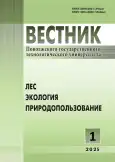Spatial Analysis of Limitations of Clearcutting in Catchment Areas Using Remote Sensing Data and GIS Technologies
- Авторлар: Borovlev A.Y.1, Elsakov V.V.1
-
Мекемелер:
- Institute of Biology of Komi Science Centre of the Ural Branch of the Russian Academy of Sciences
- Шығарылым: № 1 (65) (2025)
- Беттер: 33-45
- Бөлім: FORESTRY
- URL: https://journals.rcsi.science/2306-2827/article/view/303820
- DOI: https://doi.org/10.25686/2306-2827.2025.1.33
- EDN: https://elibrary.ru/HCHHEU
- ID: 303820
Дәйексөз келтіру
Толық мәтін
Аннотация
Logging activities significantly affect the most important functions of forest ecosystems. Forestry intensification implies not only an increase in timber harvest volumes, but also informed planning and control over the implemented activities aimed at forest restoration in felled areas. The basis for carrying out these measures rests on taking into account the landscape-ecological features of the territory where the economic activity takes place. Minimization of the negative impact of logging on ecosystems is taken into consideration in the Forest Code and in the standards of forest management of independent systems of voluntary forest certification. The purpose of the study is to develop and analyze the applicability of individual parameters for assessing the condition of exploited forest sites in the ranking of risks associated with timber harvesting. Materials and methods. The main attention is paid to the quantitative indicators that can be processed using methods of statistical analysis. The set of proposed values is based on the use of geoinformation methods, remote sensing data, and spatial analysis tools. On the example of analyzing the spatial data on the actively developed forest areas in the basins of the rivers Bol. Vizinga, Kobra, Lopyu, Nivshera, and Nizhma of the Komi Republic, additional criteria have been proposed for monitoring and assessing possible risks arising in the wood logging process. Results. In accordance with the purpose of the study, the following criteria for assessing the condition of exploited forest areas have been identified: (1) logging localization in the network of protected areas, (2) areas of clearcuts, (3) presence of intact forest areas in the vicinity of a planned logging area, (4) the mosaic of forest environment, and (5) the indicator of preservation of the water-regulating function of forests. All measured parameters are territorially linked not to administrative or forestry boundaries but to the natural landscape contours included in a single watershed. Conclusion. All of the above parameters can be used as an additional assessment of forest management sites, in land development monitoring, as well as in landscape-ecological planning. The criteria are closely related to the requirements of voluntary forest certification and allow minimizing the negative impact on the ecological functions of forest landscapes in the context of forest management intensification.
Авторлар туралы
A. Borovlev
Institute of Biology of Komi Science Centre of the Ural Branch of the Russian Academy of Sciences
Хат алмасуға жауапты Автор.
Email: borovlev.a.yu@ib.komisc.ru
Engineer, Department of Flora and Vegetation of the North, I
nstitute of Biology of Komi Science Centre of the Ural Branch of the Russian Academy of Sciences.
V. Elsakov
Institute of Biology of Komi Science Centre of the Ural Branch of the Russian Academy of Sciences
Email: borovlev.a.yu@ib.komisc.ru
Candidate of Biological Sciences, Associate Professor, Leading
Researcher, Department of Flora and Vegetation of the North, Institute of Biology of Komi Science Centre of the Ural Branch of the Russian Academy of Sciences.
Әдебиет тізімі
- Krestovskiy O. I. The impact of deforestation and reforestation on river water content. Leningrad: Gidrometeoizdat; 1986. 117 p. (In Russ.)
- Hansen M. C., Potapov P. V., Moore R. et al. High-resolution global maps of 21st-century forest cover change. Science. 2013;342(6160):850–853. doi: 10.1126/science.1244693.
- Nikitenkov A. N., Dutova D. S., Pokrovskiy D. S. Cartography and estimation of morphometrical characteristics of river basins of mountain areas on the basis of SRTM data (exemplified by the northern part of Kuznetsky Alatau). Journal of Construction and Architecture. 2013;(1(38)):223–231. EDN: PWWKQJ. (In Russ.)
- Elsakov V. V., Shchanov V. M. Satellite data in analysis of changes in ecosystems of the Vychegda River basin. Current Problems in Remote Sensing of the Earth from Space. 2016;13(4):135–145. doi: 10.21046/2070-7401-2016-13-13-135-145; EDN: WMIXKJ. (In Russ.)
- Lygyn A. N. Implementation of RFID-technologies in GIS and in the field of geodesy. Proceedings of Higher Education Institutions. Geodesy and Aerophotosurveying. 2016;60(6):105–110. EDN: XHARST. (In Russ.)
- Aksenov D., Dobrynin D., Dubinin M. et al. Atlas of Russia’s intact forest landscapes. Moscow: ISEU Publ.; Washington: World Resources Inst., 2003. 187 p.
- Volodchenkova L. A., Guts A. K. Mathematical modeling of the mosaic of forest ecosystems. Mathematical Structures and Modeling. 2020;(4(56)):49–63. doi: 10.24147/2222-8772.2020.4.49-63; EDN: DPWNVD. (In Russ.)
- Stytsenko F. V., Bartalev S. A., Egorov V. A. et al. Post-fire forest tree mortality assessment method using MODIS satellite data. Current Problems in Remote Sensing of the Earth from Space. 2013;10(1):254–266. EDN: QIXEWV. (In Russ.)
- Kuchment L. S., Gelfan A. N., Demidov V. N. A model for the hydrological cycle of a forested catchment and assessment of the changes caused in water balance by cuttings. Russian Journal of Forest Science (Lesovedenie). 2012;(6):3–13. EDN: PHFZUH. (In Russ.)
- Jones J. A., Post D. Seasonal and successional streamflow response to forest cutting and regrowth in the northwest and eastern United States. Water Resources Research. 2004;40(5):W05203. doi: 10.1029/2003WR002952.
- Onuchin A. A., Burenina T. A., Ziryukina N. V. et al. Impact of forest harvesting and forest regeneration on runoff dynamics at watersheds of Central Siberia. The Siberian Forest Journal. 2014;(1):110–118. EDN: SLRSTV. (In Russ.)
- Korytny L. M. Basin approach in geography. Geography and Natural Resources. 1991;(1):161–166. (In Russ.)
Қосымша файлдар








